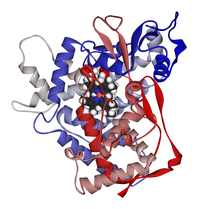
Photo from wikipedia
Effective prediction of human responses to chemical and drug exposure is of critical importance in environmental toxicology research and drug development. While significant progress has been made to address this… Click to show full abstract
Effective prediction of human responses to chemical and drug exposure is of critical importance in environmental toxicology research and drug development. While significant progress has been made to address this challenge using invitro liver models, these approaches often fail due to inadequate tissue model functionality. Herein, we describe the development, optimization, and characterization of a novel three-dimensional (3D) spheroid model using differentiated HepaRG cells that achieve and maintain physiologically relevant levels of xenobiotic metabolism (CYP1A2, CYP2B6, and CYP3A4/5). This invitro model maintains a stable phenotype over multiple weeks in both 96- and 384-well formats, supports highly reproducible tissue-like architectures and models pharmacologically- and environmentally important hepatic receptor pathways (ie AhR, CAR, and PXR) analogous to primary human hepatocyte cultures. HepaRG spheroid cultures use 50-100× fewer cells than conventional two dimensional cultures, and enable the identification of metabolically activated toxicants. Spheroid size, time in culture and culture media composition were important factors affecting basal levels of xenobiotic metabolism and liver enzyme inducibility with activators of hepatic receptors AhR, CAR and PXR. Repeated exposure studies showed higher sensitivity than traditional 2D cultures in identifying compounds that cause liver injury and metabolism-dependent toxicity. This platform combines the well-documented impact of 3D culture configuration for improved tissue functionality and longevity with the requisite throughput and repeatability needed for year-over-year toxicology screening.
Journal Title: Toxicological Sciences
Year Published: 2017
Link to full text (if available)
Share on Social Media: Sign Up to like & get
recommendations!